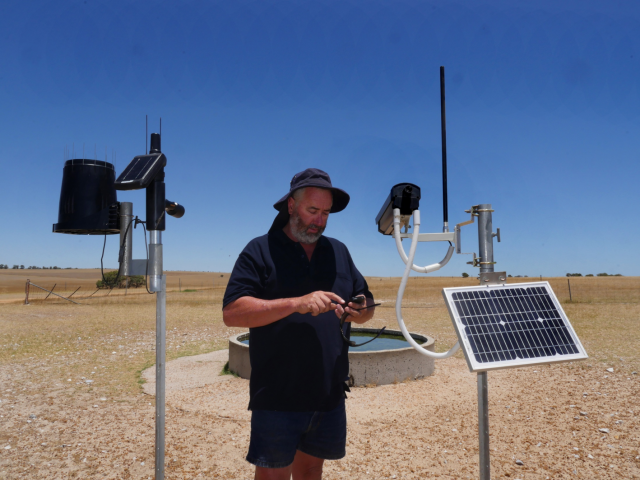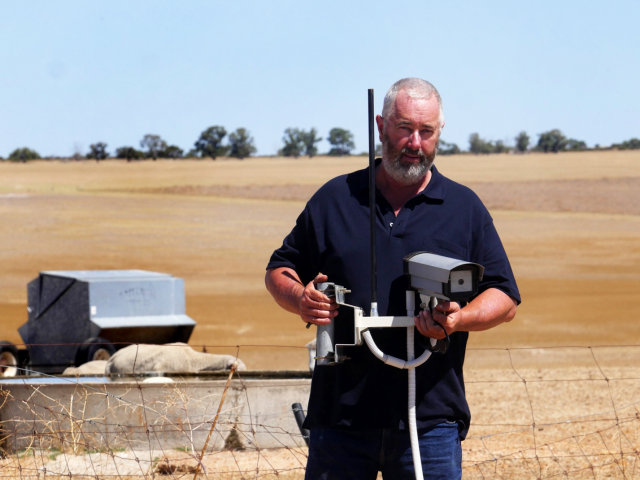 Case study: Remote farming drives efficiencies
Case study: Remote farming drives efficiencies
(An update from a Sheep Industry Business Innovation project)
- Owners: Robyn and Chris Patmore
- Property location: Five farms in the Three Springs, Irwin, Morawa and Perenjori shires
- Property size: 10 000 hectares
- Stock: 100% sheep - 4000 Merino ewe flock and Border Leicester and Poll Dorset studs
- The eastern country is leased out for winter cropping, so the sheep graze the stubbles during summer.
- Lambing: 100-115%
- Technology: Remote monitoring cameras
- Average annual rainfall: 290mm-450mm
- Technology deployed by one Mid West sheep enterprise is driving efficiencies and delivering peace of mind.
Chris and Robyn Patmore run 4000 Merino ewes as well as Riverbend Poll Dorset and Border Leicester studs on 10 000 hectares. The stock, however, are run largely on summer stubbles on five properties across four shires from the home farm in Eneabba to Morawa and Perenjori, which poses a significant logistical challenge. During summer one of the biggest chores used to be the water run. A seven hour, 350 kilometre round trip repeated every few days. “Ninety per cent of the time when you got to the troughs there was nothing wrong and you had wasted a day and usually three quarters of a tank of fuel,” Mr Patmore said.
In 2010 the Patmores invested in their first camera designed to monitor the water troughs. Now, 16 cameras later – without even leaving the house – Mr Patmore can view a snapshot of each water point on his mobile phone. More recently, the Patmores have added a new suite of electronic monitoring devices including an electronic rain gauge, water level sensors on three water tanks, and an outflow water meter on the main storage tank.
As the sole labour unit on the farm, Mr Patmore said the value of the cameras and tank monitors went well beyond simply the dollars saved. For him it’s about being more productive and being able to do other jobs rather than just driving. His roles as chairman of the Pastoralists and Graziers’ Association livestock committee and chairman of the Central Wheatbelt Biosecurity Association also mean that he spends a bit of time off farm. The cameras enable him to still keep an eye on the watering points and even the dog while he is away. “It’s better peace of mind when you are away and better time management when you are at home,” he said. “I am still busy all of the time and I still do nearly as many kilometres on the road but I am just more productive – I can be fencing or doing other things instead of just driving around checking troughs.”
The cameras and monitors allow for as frequent checking of the troughs and tanks as desired, potentially six or eight times a day; it just takes a minute each time. “I wouldn’t be able to run the sheep scattered around the different properties without the cameras - it is just a time factor. I wouldn’t farm without them now.”
The cameras are just part of the picture. Mr Patmore is adamant that sheep don’t need to be hard work - with the right facilities. To this end he also has undercover work areas in the yards and a laneway system to make managing his stock easier.
Camera set-up
Two different brands of cameras act as remote eyes watching whether the Patmores’ sheep are drinking or if there are any problems with the water. They are the uSee remote monitoring camera and the Observant camera. Both units are solar powered and take time-lapse and on demand images. The tank monitors were purchased through WA-based company Origo Farm.

Each farm is supplied by underground water which is pumped and then gravity-fed into tanks.
Some tanks still rely on a level gauge which can be seen from a distance and come into the field of view of the cameras. The camera takes images of the trough in the foreground and tank in the background, capturing the water level in the trough and tank in one shot. On key tanks, these level gauges have been replaced with an electronic water level sensor.
Given issues of network coverage in the bush, Mr Patmore also pointed out that the devices didn’t need much of a mobile signal to still send photos or data. “You can have a camera 20 or 30 kilometres from a mobile phone tower and it still works fine,” he said. “Even if you can’t make a phone call you can usually get a photo out of the camera because they each come with a broomstick aerial which gives a lot better coverage than a normal handheld phone. “If you can’t get any signal you can use a satellite SIM card – it works out slightly more expensive but if you can’t get a Next G signal it is an option.”
Adapting the system
Mr Patmore describes the camera system as “plug and play” but has made a few of his own modifications along the way. “These cameras are set up to be mounted on a pole permanently but I have modified them to be portable, just with a thumbscrew, so they can be lifted off and you can throw them on the back seat of the ute and off you go,” he said. “When you shift a mob of sheep you shift the camera with the sheep.” Hence for the 16 mobs of sheep that the Patmores run, there are 16 remote monitoring cameras.

Mr Patmore showing how he can move the camera around as he moves the sheep – they are simply mounted on a piece of pipe welded onto a star picket.
Mr Patmore has found the cameras pretty reliable, apart from the odd hardware problem due to the harsh environment. The camera wires however proved not to be cockie proof. “Probably the biggest problem I have had is the cockatoos chewing the wires - so I have had to put conduit on the wires,” Mr Patmore explained. “The cockatoos also learnt to turn the switches off so I had to put shrouds over the switches.”
A picture tells a thousand words
With just the click of a button and a mobile phone the photos can be viewed from anywhere. Mr Patmore said it was simply a case of logging into the website of whichever camera system was being used and entering a username and password. His cameras are set to take photos every three hours but it is also possible to take a photo on demand. “You can take as many photos as you like per day. You have complete control over them,” Mr Patmore said.
He explained that having a visual picture was the key. “I like to be able to see the sheep are drinking – you can see them come in and have a drink,” he said. “You will see some walking towards the trough and some walking away – it’s only a still picture.
“If you see a big mob of sheep bunched before a trough and they are still there a couple of hours later you know something is wrong - there is manure in the trough or the water is all horrible and they are not drinking.
“I have been in Perth in one instance and I was watching the tank gauge go down and down but I figured I still had a day to get home and sort it out before it ran out of water. “The good thing was I knew about it - I could handle it, whereas if I hadn’t known I would have arrived back to the farm two or three days later and the sheep would have been out of water and there would have been a big panic. “So it’s peace of mind. You can get away for two or three days at a time and know that there is nothing wrong or if something does go wrong you can get something done about it.”
Business case
Mr Patmore said that capital and running costs of the technology was easily justifiable.
Economist Peter Rowe analysed the Patmore’s investment in camera technology on behalf of the Royalty for Regions-supported Sheep Industry Business Innovation project in 2017. Mr Rowe concluded the cameras had enabled Mr Patmore to cut his water runs from 60 a year to around 18, saving 42 runs.
For an initial investment of $22 500 for 15 cameras, the savings in wages and fuel and vehicle operating costs including depreciation and interest savings represented $21 400 a year.
This assumes a labour cost of $46/hr including on costs, vehicle operating cost of 70c/kilometre and that the seven hour, twice weekly, 350km run is only done for the summer months.
Mr Rowe said the Net Present Value for the investment was $142 000, at a discount rate of 6 per cent over 10 years, while the payback period for the 15 cameras was just two years.
Although the Patmores’ water run covers a few hundred kilometres, Mr Rowe said the distances travelled didn’t need to be anywhere near that for the camera technology to be profitable.
“Even if you travel five kilometres from the farm house to the back paddock and back, once a week during summer, the technology starts to pay for itself,” Mr Rowe said.
Acknowledgement
The Sheep Industry Business Innovation project was funded by Royalties for Regions and supported new technology to make running sheep easier.
Disclaimer
Mention of product names should not be taken as endorsement or recommendation.
